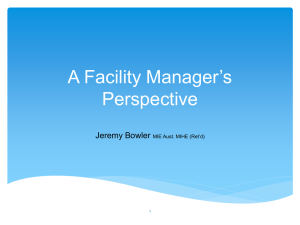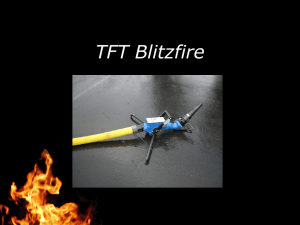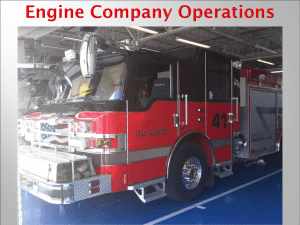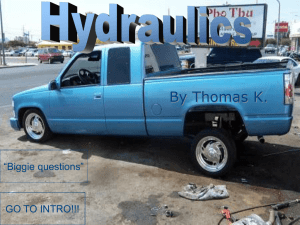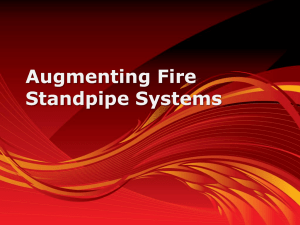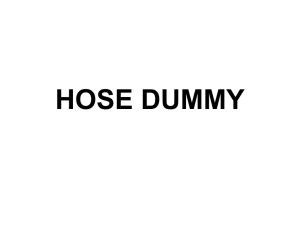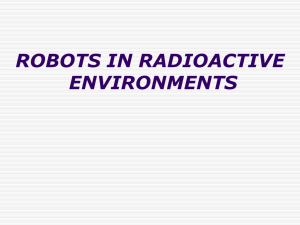Fire Service Hydraulics - Lonestar Fire Specialties
advertisement
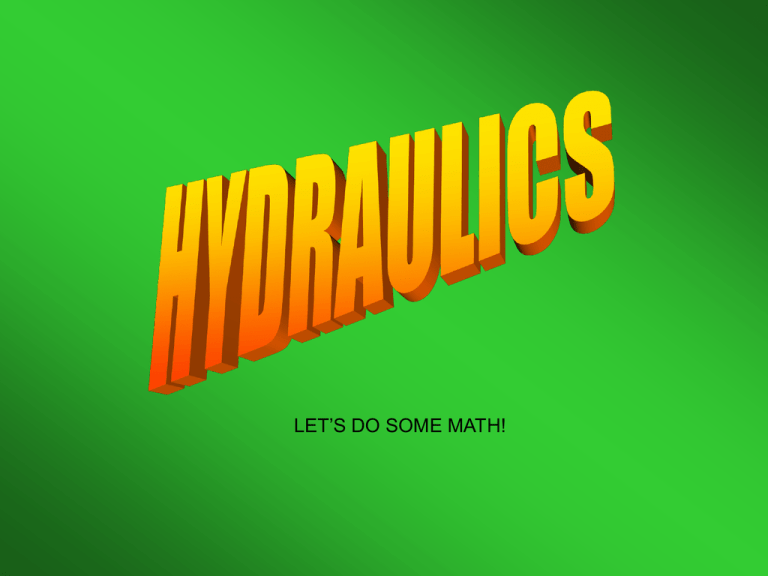
LET’S DO SOME MATH! Fire Service Hydraulics During this presentation, we are going to explore the how and why of fire service hydraulics. We are going to start out fairly basic, and with each detail we cover, we will discover why it is important to know this material, and how it affects our performance on the fire ground. Fire Service Hydraulics Some of this information may not be directly related to ‘hydraulics,’ but you will see how it ties together. Whatever happens, don’t be intimidated by the math. We’ll take it one step at time so that it is completely understandable. For some, this is fairly new territory, and for others, it will be a good refresher. Let’s get started. Fire Service Hydraulics Why are hydraulics critical? We want the fire fighter to fight the fire, not the hose line. That is why knowing fire service hydraulics is so critical. Knowing hydraulics gives the fire engineer important safety information He needs to know: • what the apparatus discharge pressures need to be, • how much friction loss will he have to deal with, • how much water is left in a hydrant. Fire Service Hydraulics It is critical to understand where the numbers come from when operating an apparatus pump. Odds are, your fire department has a “rule of thumb” regarding pump pressures for pre-connected hose lines or lines that are used more often. Therefore, you don’t have to remember or try to use these formulas at a fire. Unless the hose lay is different from what you are used to, a “rule of thumb” should work fine. BE AWARE … If you don’t know these formulas, you will one day need them because of a different hose lay, and it will happen at the worst possible time. Fire Service Hydraulics Let’s go over some definitions Order of Operations Co-efficient Square & Square Root More to come … Fire Service Hydraulics Order of Operations This is one of those math rules we have to live with. It basically states that certain math operations (add, subtract, multiply, divide) will be completed prior to others. Rule 1: First perform any calculations inside parentheses. Rule 2: Next perform all multiplications and divisions, working from left to right. Rule 3: Lastly, perform all additions and subtractions, working from left to right. Please Excuse My Dear Aunt Sally #1 Parenthesis #2 Exponents ( sq and cubes) #3 Multiply #4 Divide #5 Add #6 Subtract Please Excuse My Dear Aunt Sally Here’s an example 4+5x6–7 1st is to multiply 5 x 6 = 30 4 + 30 - 7 2nd is to add 4 + 30 = 34 34 - 7 Lastly, subtract 34 – 7 = 27 27 is the answer. Fire Service Hydraulics Why is this important? When calculating friction loss formulas, the order of operation is critical otherwise you will not get the correct answer. Remember the 6 steps and you can’t go wrong. Co-efficient Co-efficient is the resistance of one material passing next to another material. For example, water passing next to the material inside of a fire hose. For our purposes, we will define Co-efficient as the resistance to flow of water inside of a hose. Fire Service Hydraulics Why is this important for me to know? With every different size, length and type of fire hose, the amount of resistance to water flow will change. When the resistance of flow changes, the pressure needed at the pump discharge will also change. Co-efficient The Coefficient of a fire service hose is expressed with a numerical value. The higher the numerical value, the higher the coefficient. This means that more energy is required to push the water through the fire hose. Square(²) and Square Root (√) To find the square of a number, simply multiply that number times itself. Example -- 4² = 16 is the same as 4 x 4 = 16 Or 7.07 ² which is 7.07 x 7.07 which equals 50. FYI- 50 happens to be the nozzle pressure for hand lines with smooth bore nozzles. Square(²) and Square Root (√) For square root (√) operations, we must determine the two exact numbers, that when multiplied by each other, equal the number that we already have. (clear as mud?) The square root of 64 is 8. 8 x 8 = 64. Easy enough. It is written to look like this √64 = 8 Square(²) and Square Root (√) Fortunately for us in the fire service, there are only two main square roots we need to know. They are 50 and 80: • 50 is the amount of pressure for a hand line with a smooth bore nozzle • 80 is the amount of pressure for a master stream device with a smooth bore nozzle Fire Service Hydraulics With this information, let’s find the square root ‘√’ of these two nozzle pressures. 1st – smooth bore pressure of a hand line is 50 psi √50 = 7.07 2nd – smooth bore pressure of a master stream device is 80 psi √80 = 8.94 Fire Service Hydraulics Let’s try a couple more square root problems with a calculator. √81 = ? √36 = ? √88 = ? *NOTE* Go to the next slide for some tips on using the Windows calculator. Fire Service Hydraulics A couple of tips for using Windows® calculator: With Windows calculator using square roots, enter the number that you want to find the square root of and then click “sqrt”. To find a number’s “square” with this calculator: Select ‘View’ ‘Scientific’ Enter the number you would like to square, and then press the “x^2” key Note: You will need the decimal equivalent of the fraction part of the tip size to enter into the calculator. The next slide has a table with fraction and decimal equivalents. Fire Service Hydraulics To find the decimal equivalent of any fraction, divide the top number by the bottom number. Fraction Decimal 1/16” .0625 1/8” .125 1/4” .25 3/8” .375 1/2” .5 5/8” .625 3/4” .75 7/8” .875 Fire Service Hydraulics Did you get … √81 = 9 √36 = 6 √88 = 9.380831519646859109131260227 To shorten this a bit we’ll say 9.4 Please Excuse My Dear Aunt Sally O-K Now, let’s put a couple of the things we’ve learned together. 4 * √49 = ? Did you get… 4 * √49 = 28? Please Excuse My Dear Aunt Sally Let us try another one … 5.5 * 2.5² Did you get … 5.5 * 2.5² = 34.375 Excellent! Fire Service Hydraulics The following formula is the one that will be used the most. This little math formula will work with fog nozzles and smooth bore nozzles. We are going to find Friction Loss using only hoses, no appliances. (example: a gated wye) Fire Service Hydraulics Finding Friction Loss FL = C*Q²*L FL = Friction Loss C = Friction Loss Coefficient Q² = Flow rate in hundreds of gallons (flow/100 and then squared) L = Hose length in hundreds of feet (length/100) Fire Service Hydraulics We’ll start off with “C” which is the hose coefficient. “C” = the resistance to flow of water inside of a hose. The table on the next slide lists several sizes of fire hoses and their coefficients. Fire Service Hydraulics You can print this for future reference this is slide #27 Hose Size ¾” redline 1 ½” line Coefficient 1,100 24 1 ¾” line with 15.5 1 ½” couplings 2 ½” 2 3” .8 4” 0.2 5” 0.08 Fire Service Hydraulics Next is “Q²” which is the flow rate of the water. Note: Unless you know the flow rate of the nozzle that you are using, you will have to use another formula (which we will discuss later) to find your gallons per minute. Once this value is known, we have to divide it by 100 and then square the result Q= (nozzle flow/100) ² Fire Service Hydraulics Now, let’s try one. Using an adjustable gallonage fog nozzle with the flow rate set at 125 gallons per minute. Divide 125 by 100= 1.25 Then square it, 1.25² = 1.56 Fire Service Hydraulics “L” = Total feet of hose divided by 100. Example: 150 feet of any size hose is 150 / 100 = 1.5 Note: Hose diameter is not important for this part of the equation. Also note: Some fire service hydraulic calculations use hose length as 100’ minimums, even if it requires two sections to make a 100’. We will look at these in more detail later on. Fire Service Hydraulics Now let’s put this together. 150 feet of 1-1/2” hose flowing 125 gallons per minute. We know that we need 100 pounds of pressure at the fog nozzle. Fire Service Hydraulics FL = C*Q²*L C=24 (from the hose coefficient table) Q²=1.56 (125 gallons per minute divided by 100 and then squared) L=1.5 (150 feet of hose divided by 100) Our formula is: FL=24*1.56*1.5 Fire Service Hydraulics FL=24*1.56*1.5 Did you get … FL = 56 ? Let’s try another one. Fire Service Hydraulics FL = C*Q²*L You are flowing 250 gallons per minute through 2-1/2” line that is 200 feet long. Fire Service Hydraulics Did you get FL = 25 ? Very Good. We know now that we have 25 psi of friction loss in our hose lay. Remember, we have to have 100 psi at the nozzle for adequate water flow. With that said, what does our pump discharge pressure have to be? Fire Service Hydraulics Let’s have another formula for that. EP = NP + FL EP = Engine Pressure (pump discharge pressure) NP = Nozzle Pressure (which is 100 psi) FL = Friction Loss (which we now know is 10 psi) EP = 100 + 25 Engine Pressure (pump discharge pressure) = 125 psi Fire Service Hydraulics Remember, we want the fire fighter to fight the fire, not the hose line. That is why knowing fire service hydraulics is so critical. Fire Service Hydraulics We mentioned about finding flow rates or gallons per minute (GPM). Before we go any further, the following formula is used for smooth bore nozzles. Depending on the region and department you are on, you might not use smooth bore nozzles often, but it is important to know how this formula works. GPM for smoothbore nozzles The formula used to determine GPM for smoothbore nozzles. GPM = 29.7 * d² * √NP Fire Service Hydraulics GPM = 29.7 d² √NP • 29.7 is a constant • d² = the diameter of the nozzle squared • √NP = square root of the nozzle pressure – Master stream devices operate at 80 psi therefore the square root will be 8.9 – Handline devices operate at 50 psi therefore the square root will be 7.07 Fire Service Hydraulics What is d² when using a 1-1/4 inch smooth bore tip? 1-1/4² Or 1.25 * 1.25 (Refer to slides 20 & 21 if you need assistance) Did you get 1.56? Great! Fire Service Hydraulics Finally, the square root (√) of the Nozzle Pressure (NP) We discussed earlier that the nozzle pressure for a smooth bore master stream device is 80 psi. So, the square root of 80 is 8.9 √80 = 8.9 Fire Service Hydraulics O-K, let’s put it together. GPM = 29.7 * d² * √NP Our example: We are flowing a hand line with a 7/8” smooth bore nozzle. Fire Service Hydraulics O-K, Did you get 160 GPM? GPM = 29.7 * d² * √NP gpm = 29.7 * .765 * 7.07 gpm 22.7 * 7.07 160 gpm The next slide is very important. Fire Service Hydraulics CHEAT! Every Chance You Get! Not on a test, but at a fire. Use EVERYTHING to your advantage at a fire. The fire does not care! With that being said, Remember two things:* Fire Service Hydraulics *The square root of a smooth bore nozzle on a hand line is 7.07 *The square root of a smooth bore on a master stream device is 8.9 Use the chart with decimal conversions on slide #20. Develop your own conversion charts that you have easy access to at a fire. If you do this, you will not be known as a ‘cheater’ but as being clever. Your chief will say, “That engineer knows his stuff”. Use everything to your advantage. Fire Service Hydraulics Let’s try one more GPM formula. You are flowing water through a master stream device with a 1-3/8” tip. GPM=29.7 *d² * √NP Fire Service Hydraulics O-K, Did you get 499 GPM? EXCELLENT ! If you have any questions about this stuff don’t hesitate to let me know. I can be reached via e-mail at dale@lonestarfirespecialties.com Please include your phone number on the e-mail thanks Fire Service Hydraulics Next Step: We have discussed finding friction loss, engine pressure, and gallons per minute. Let’s put it together. You are pumping at a commercial structure fire. You have a hand line on the ground with 200 feet of 1-3/4” hose with a 3/4” smooth bore tip. What is your: 1: GPM 2: Friction Loss 3: Engine Pressure Fire Service Hydraulics Let’s start with GPM. We have a hand line (7.07) with a 3/4” (.75) tip. GPM = 29.7 * d² * √NP GPM = 29.7 * .56 * 7.07 Fire Service Hydraulics Did you get 118 gallons per minute? Good. Now we have to find friction loss. FL = C * Q² * L Fire Service Hydraulics Friction loss FL = C * Q² * L We know from the chart on slide 27 that C = 15.5 and the flow is 118 gpm. Don’t forget we divide the flow by 100 and then square it. 118 / 100 = 1.18 1.18² = 1.39 Q² = 1.39 So far we have FL = 15.5 * 1.39 * L L is the total length of the hose divided by 100 200 / 100 = 2 THUSLY, FL = 15.5 * 1.39 * 2 Fire Service Hydraulics Did you get 43 pounds of friction loss? Great! Now all we need is (EP) Engine Pressure Fire Service Hydraulics (EP) Engine Pressure EP = NP + FL EP = 50 + 43 EP = 93 psi Fire Service Hydraulics Wonderful. So, our answers are: 1: GPM is 118 gpm 2: Friction Loss is 43 psi 3: Engine Pressure is 93 psi Fire Service Hydraulics One more … (This part’s almost over) You are operating your apparatus at a commercial structure fire with 250 feet of 2-1/2 inch hose on the ground and a 1-1/4” inch nozzle. Find… 1: GPM 2: Friction Loss 3: Engine Pressure Fire Service Hydraulics Here are the formulas you will need: GPM = 29.7 *d² * √NP FL = C * Q² * L EP = NP + FL Remember… (any flow over 350 gpm is considered a master stream) Good Luck & Don’t Cheat. Cheat on the Fire Ground! Fire Service Hydraulics Did you get: GPM = 413 gpm FL = 69 psi EP = 149 Moving right along … Fire Service Hydraulics The next section of fire service hydraulics we are going to cover deals with everything else. We will discuss: • nozzle reaction, • friction loss due to appliances • pressure loss or gain due to elevation. Nozzle Reaction Let’s start with Nozzle Reaction. The main purpose for knowing about nozzle reaction is to illustrate the force that pushes back on the nozzle as water is flowing. If the nozzle is closed there is no nozzle reaction. Sir Isaac Newton’s laws of physics play a major role in understanding what we, as engineers, need to know and have to deal with on the fire ground. Nozzle Reaction Newton said: For every action, there is an opposite and equal reaction. Have you ever operated an attack line and the engineer had the pressure too high? You were fighting the nozzle and hose instead of the fire. This will explain why. Nozzle Reaction There are two formulas for calculating nozzle reaction; one for smooth bore and one for fog nozzles. We’ll talk about smooth bore first. NR = 1.57 * d² * NP NR = Nozzle Reaction 1.57 is a constant d² is the diameter of the nozzle, squared NP = nozzle pressure Nozzle Reaction If we have a hand line with a 7/8” tip, what will the nozzle reaction be? NR = 1.57 * d² * NP Let’s start with diameter. d² = .765 We know that because this is a hand line the NP will be 50. Therefore…. NR = 1.57 * .765 * 50 NR = 60 psi (click here refer to slide #20 for fraction to decimal conversion) Nozzle Reaction 60 psi is how much pressure your firefighter is having to overcome to fight the fire. Let’s try one more You have a 1-1/8” tip operating as a master stream device. What is the nozzle reaction? NR = 1.57 * d² * NP Nozzle Reaction Did you get 158 psi? Great! This illustrates how much counterforce your firefighters are having to deal with while fighting the fire. THIS is why it is important to pump the correct pressures. One more, and that’s fog nozzles Nozzle Reaction The formula for finding nozzle reaction for a fog nozzle is: NR = 0.0505 * Q * √NP A couple of differences: In this equation, Q is total flow. It is not flow divided by 100 and squared. Nozzle Reaction • The second difference is with fog nozzles we take the square root of the nozzle pressure, NOT square the nozzle pressure as with the smooth bore. Nozzle Reaction Let’s try this one. NR = 0.0505 * Q * √NP Actually, this one is a bit easier because we already know that most fog nozzles operate at 100 psi, therefore the square root is 10. If we have a fog nozzle flowing 150 gpm, our formula looks like this. NR = 0.0505 * 150 * 10 (0.0505 is this formula’s constant) What is the Nozzle Reaction? Nozzle Reaction Did you get 75 psi? Great Job!! Try one more. You have a fog nozzle flowing 200 gpm. Nozzle Reaction Did you get 101 psi? The point to this is: If you pump your apparatus correctly, life will be easier on your firefighter. You will be a hero, not a zero. Moving right along. Friction Loss due to Appliances What is an appliance? An appliance is any fire related device through which water will flow. • Friction Loss due to appliances in hand lines is typically not factored into the equation. • As a general rule of thumb, calculate the friction loss of EACH appliance at 10 psi when flow is >350gpm. • Aerials and Master Streams are 25 psi. Now, let’s look at a formula we have already worked, and modify it a little bit. Friction Loss due to Appliances EP = FL + NP Look familiar? We are going to add in friction loss from one appliance into this equation. EP = FL + AFL + NP *note* for our illustration we are using “AFL” for appliance friction loss. There are many ways to express this equation. We are doing this for clarity only. IFSTA® pumping apparatus handbook chapter 8 has more information on this topic. SO … Friction Loss due to Appliances EP = FL + AFL + NP If we have two appliances, example a Siamese and a reducer, AFL will equal 20 psi. So, all we need to do when creating this equation is add 20 to the friction loss of the hose and to the nozzle pressure. Pressure Loss or Gain due to Elevation • How high is the nozzle above you? • How low is the nozzle below you? These two questions will need to be answered so that you, the engineer, can supply your firefighters with the correct pressure. Fire Service Hydraulics Water column is the amount of pressure exerted by a one foot tall column of water. A one foot tall column of water exerts .434 psi of pressure. (not to be confused with weight) Real close to ½ pound. For ease of calculations, we’ll say for every 1 foot of elevation, we’ll add 1/2 pound of pressure to our pump. O-K, have you ever tried adding 1/2 pound of pressure to your pump? Pressure Loss or Gain due to Elevation We will call these pressure differences either +EL or –EL for elevation gain or loss. In other words, if your firefighter is operating above your pump on a hill that is approximately 40 feet high, then you will need to do WHAT? Add 20 psi to your pump pressure. This is based on water column pressure. Elevation Loss How about this, for every 10 feet of elevation, let’s add 5 psi to our pump pressure. Each floor of a building =10 ft or 5 psi Simple Enough … Elevation Loss If we have 40 feet of elevation, let’s add that to our equation: EP = FL + EL + NP So, we have • Friction Loss of the hose line • Friction Loss due to elevation & • Nozzle Pressure. Elevation Loss If you have any high rise buildings in your response area, friction loss due to elevation will definitely need to be Added to your EP. Fire floor -1 * 5 = EL EL is the same if you are pumping to a • • hose line that is running up the stairs standpipe that is installed in the building,. Fire Service Hydraulics What happens if our fire operation is below grade? The same 1/2 pound per foot rule still applies, but the difference is we subtract that pressure from our pump discharge pressure. IF your fire ground is below the pump, in a small valley, where your apparatus cannot gain access, and it is 40 feet below the pump, then … Fire Service Hydraulics Subtract 20 pounds of pressure from your pump discharge pressure. EP = FL + NP – EL Friction Loss of the hose (plus) Nozzle Pressure that is required (minus) Elevation Fire Service Hydraulics We’ve done all of this math. WHY? The reason: These formulas are the foundation of what we do as Engineers on a fire truck. While we might not use these formulas at all fires, we need to know where the numbers for the pressures and flows come from. Fire Service Hydraulics As mentioned earlier, nozzles are purchased for a variety of reasons. It can be because of brand loyalty, pattern characteristics, or price. Fire Service Hydraulics All fog nozzles, whether they are adjustable, constant or automatic, will have a flow rating attached to them. Typically, a certain flow rate at a certain pressure, AT the nozzle. Now to get this flow rate correct, you have to have the correct pressure at the nozzle which means you have to compensate for Friction Loss. Fire Service Hydraulics We have spent some time going over the mathematical formulas for finding friction loss. Please know that this is IMPORTANT information. With that being said, let’s cheat. How is the best way to determine the flow rate of a fog nozzle? Fire Service Hydraulics We have pre-fire plans for our buildings. The strategies and tactics are outlined, and we have a good idea of what we’ll do when we get there. Let’s do the same thing for operating our apparatus pump when we get there. Just like pre-fire plans, it will take a little effort. What we want to do is determine the flow and pressure from a variety of hose line and appliance configurations. We’ll start by connecting different hose lines and nozzles. Fire Service Hydraulics Connect your hose lines in a configuration that you might use someday on a fire. Somewhere, between the pump and nozzle, install a flow meter. Begin flowing water until the flows are correct and then write down the Engine Pressure. Simple Enough. (No Flow meter? Check with your local water company. Many have flow meters with standard 2-1/2” fire service threads that they will let the fire department use at no cost.) Fire Service Hydraulics Example Chart For Calculating Engine Pressure (You are welcome to use this chart for any of your equipment, or develop your own chart for the specific needs of your department. You’re only limited by your imagination!) Hose Length Hose Diameter Nozzle Flow Rate Engine Pressure Test 1 150’ 1-3/4” adjustable 95 120 psi Test 2 150’ 1-3/4” adjustable 125 136 psi Test 3 150’ 1-3/4” automatic 150 152 psi Test 4 150’ 2-1/2” automatic 275 121 psi Test 5 250’ 2-1/2” automatic 275 138 psi Test 6 250’ 1-3/4” SB 7/8” 160 129 psi Fire Service Hydraulics So far, we have discussed calculations that are based on hose coefficients and appliance friction losses that are, well, kind of old. With new technology, the friction loss of fire hoses and appliances has decreased through the last 20 years. LoneStar Fire Specialties recommends that you conduct your own tests, with the equipment that you actually carry on your apparatus and develop charts that can and will assist you, as an engineer, on the fire ground. They are easy to create, although it does take a little bit of effort. We believe that you will find it to be well worth your time. Fire Service Hydraulics Now, let’s look, briefly, at a comparison between hose sizes and what we are capable of flowing through them. For our example, we will assume that we are flowing 200 gallons per minute through a 150 feet of hose with a fog nozzle. What size hose will we need to flow that amount of water? ( Remember our Friction Loss Formula.) Fire Service Hydraulics FL = C * Q² * L If we use 1-1/2” hose, this is the equation: FL = 24 * 4 * 1.5 Our friction loss is 144 psi ! For a total discharge pressure of 244 psi. If we use 2-1/2” hose, this is the equation: FL = 2 * 4 * 1.5 Our friction loss is 12 psi For discharge pressure of 112 psi. See the difference. Fire Service Hydraulics Quick Note: NFPA 1911, pump testing, only requires an apparatus to pump 70% of rated flow at 200 psi. Flowing too much water through too small of a hose will needlessly overwork the engine. Fire Service Hydraulics Now, let’s talk about some math that you really do need on the fire ground. We have gone through and developed our charts for all of the hoses, nozzles, and appliances that we carry on the fire truck. That stuff will remain constant. Question: What do we have on the fire ground that is NOT constant, is dynamic, is always different, and can change in the middle of a fire? The Fire Hydrant Illustration courtesy IFSTA® Fire Service Hydraulics In this part of the presentation we’re going to talk about fire hydrants, our source of water. We don’t want the word ‘critical’ to become overused, however, knowing how much water you have in your fire hydrant is critical. We are going to look at some more math formulas to determine how much water is left in a hydrant. It is always good to understand how to get to the correct answer by using formulas but, during the hands on training day we will show you a very practical and effective way to determine if your hydrant will support additional flow. Fire Service Hydraulics These are the formulas available for the engineer to use to find the amount of water available in a hydrant #1 Percentage Method #2 First Digit Method #3 Squaring The Lines Method Fire Service Hydraulics With all available math formulas for calculating how much water is left in a fire hydrant, all of them require that the engineer know the static pressure. If you will remember from the Water Supplies presentation, the difference between static pressure and residual pressure is that static pressure is water at rest, that is, it is not moving (flowing) into the fire pump. Fire Service Hydraulics If water is flowing into the fire pump, then the residual pressure is what’s left over. Again, in order to use these formulas, you have to know what the static pressure is. In order to do that, you have to know how to read gauges and understand what they are telling you. In many cases, you will use water from the booster tank to begin fire fighting operations, and then as more companies arrive, the engineer will be able to get a constant water supply. Fire Service Hydraulics Since that is the case, how can the engineer know what the static pressure is? You have to be quick and paying very close attention to your pump panel. With that, let’s look at the percentage method. We covered the percentage method in Water Supplies. We may have mentioned that it is critical to know how much water you have left in a hydrant. No matter which formula or method you choose to use. Fire Service Hydraulics A quick note about the order of operations If any numbers are in parenthesis (), they are to be calculated first. For example: (6+4) * (2+3) = 10 * 5 or (6 + 2²) * (3 + √16)= (6 + 4) * (3 + 4)= 10 * 7 <<<< Onward >>>> Fire Service Hydraulics Percentage Method Percentage drop = (Static – Residual)(100) / Static Example – One line flowing 200 gpm Static pressure 70 psi Residual pressure 63 Percentage drop = (70-63)(100)/70 Percentage drop = (7)(100) / 70 Percentage drop = 700 / 70 Percentage drop = 10% Now what? Fire Service Hydraulics Our answer is 10%. By using the chart on the right, we can get very close and estimate how much water is left in the fire hydrant. According to the chart, with 10% left, we have at least 3 times the amount of water that is currently being used. If we are already flowing 200 gpm, this chart indicates we have at least another 600 gpm available. % decrease of pumper intake pressure Additional water available 0-10% 3 times amount of water being delivered 11-15% 2 times amount of water being delivered 16-25% same amount of water being delivered Over 25% More water MIGHT be available Fire Service Hydraulics Summary Fire Service hydraulics are the basis for what we as engineers do. Not only are we responsible for getting our crews to the scene and back safely, but we have to operate the truck correctly when we get there. Use what you have learned. Give your firefighters a break, don’t make them fight the hose. When LoneStar Fire Specialties comes to your department, you will see first hand how all of this information can affect your job performance on the fire ground. Fire Service hydraulics isn’t the most fun you can have, but this we guarantee, during the hands on training, You will have a blast! We’ll see ya soon! And again, if you have any questions about this topic or any others, please let me know. e-mail to dale@lonestarfirespecialties.com Please don’t forget to include your phone number. Thanks and have a GREAT Day !
